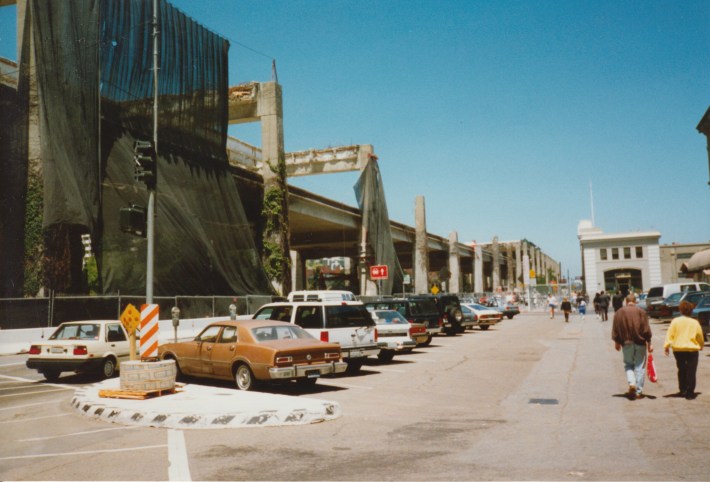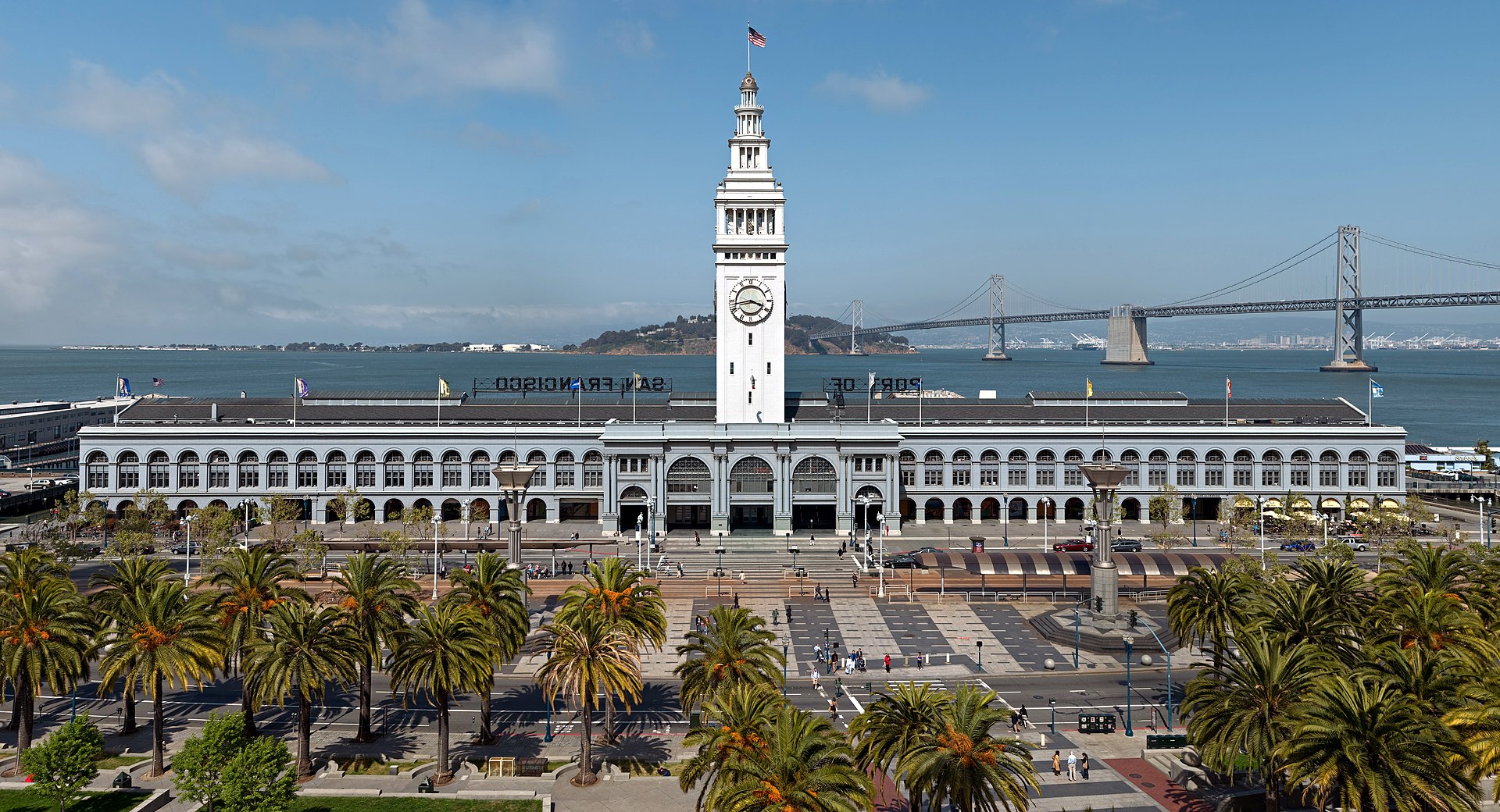Editor note: whenever the conversation turns to removing I-980 in Oakland and the 101 and 280 spurs in San Francisco, it's a good idea to remember that a few decades ago voters were dead-set against removing the Embarcadero Freeway in San Francisco. In retrospect, it's hard to imagine that people actually designed, built, and fought to protect such a ghastly structure. That's why when the San Francisco Chronicle's urban design critic, John King, asked if Streetsblog wanted to publish the following chapter from his book about the history of the San Francisco Ferry Building and the surrounding area, the answer was "yes!" The story of the Embarcadero Freeway is a real indication of the, uh, seismic shift in attitudes towards car-dominated infrastructure that can take place over time.
***
From chapter 10 of “Portal: San Francisco’s Ferry Building and the Reinvention of American Cities,” by John King. Published by W.W. Norton, Nov. 2023.
LOGICALLY, THE BALLOT MEASURES IN JUNE 1986 TO TEAR DOWN the Embarcadero Freeway should have passed by landslide margins.
San Franciscans famously had loathed the double-decked concrete intruder since before it opened in 1959. Mayor Dianne Feinstein and the Board of Supervisors were united in their desire to replace the mile-long viaduct with a landscaped boulevard that would “once again let us see our waterfront,” as Feinstein concluded her argument in the election’s voter information handbook. Her pitch was flanked by endorsements from all parts of the city’s political, economic, and cultural spectrum. One person calling for the viaduct to vanish was the developer of Pier 39, a wildly popular tourist and family mecca that had the look of an ersatz fishing village and had opened in 1978; another was Jack Morrison, who fought Pier 39’s creation and had been the only member of the Board of Supervisors to vote against the Transamerica Pyramid back in 1969. Also weighing in: Lawrence Ferlinghetti, the revered poet who still presided over City Lights Bookstore, was among the authors of a plea that the waterfront should be “graced by a grand promenade.”
The freeway defenders in that handbook? Few and far between. One argument was signed by several leaders of the local Republican Party, hardly a ringing endorsement in an increasingly liberal city. Another was from the San Francisco Taxpayers Association, which routinely challenged any measure involving public expenditures. The only elected official against the idea, Supervisor Richard Hongisto, warned vaguely that tearing down the freeway “will aggravate an already bad traffic problem” and “be very expensive.” More studies were needed, critics agreed; they didn’t say what those studies should be.
Then came election day, and logic was turned on its head. The people who wanted to get rid of the supposed scourge were no match for an opposition that preferred to see nothing happen at all rather than take a chance on the unknown. Both measures went down to lopsided defeat.

A similar dynamic was playing out around this time with the Ferry Building: a proposal that had been touted in 1981 as the best chance yet to revive the faded landmark’s former glory had foundered. Instead of being rejected by voters, it was in limbo and headed to court.
The story lines were different, and in the case of the Ferry Building, we’re better off as a result. But each saga fit with a larger trend during the 1980s. The culture of opposition that had emerged during the 1960s, the tenacious and often inventive resistance to top-down initiatives that threatened the city’s quality of life, had hardened into force of habit.
Feinstein called the defeat of efforts to remove the Embarcadero Freeway “a vote for the automobile.” One of her campaign leaders fingered a different culprit. “We did everything we could short of collaring people on street corners,” he said the day after the election. “But the general reaction to everything is ‘no.’”
As early as 1973, Feinstein had vowed, “I’m determined that that freeway come down, if I have to become totally gray-haired in the process.” Once she became mayor, her administration started making the case to regional transportation and planning agencies that the viaduct was no longer wanted, even though it carried fifty thousand cars a year. The surface boulevard sketched out in the recently approved plan for the southern Embarcadero would suffice to handle the displaced traffic, they argued, and much of the cost could be covered by state and federal funds already promised to the city.
In November 1985, the Board of Supervisors voted overwhelmingly to bring sunlight back to the Embarcadero. Feinstein signed the legislation in a ceremony held in a parking lot beneath what she called a “concrete monolith that divides our neighborhoods.” Other cities were starting to make similar moves: on the East Coast, engineers with the Massachusetts Department of Transportation were planning to replace Boston’s much-loathed Central Artery through the center of the city with an underground highway. New York’s West Side Elevated Highway, a lumbering single-deck viaduct mostly built in the 1930s when Manhattan’s working waterfront still flourished, was on the verge of being dismantled to make way for a surface roadway and extensive parks. The Freeway Revolt had evolved from battling proposed intruders to, also, trying to take down the old ones that blocked a new generation of residents from creating the city they desired.
But if environmentalists and neighborhood activists saw their quest in the context of what could be gained—“the waterfront will be opened up to sunlight and fresh air,” in the words of the Sierra Club—skeptics focused on what could be lost, beginning with direct access from the Bay Bridge to the districts north of Market Street. This wasn’t just the complaint of Bay Area residents who liked their straight aerial shot to North Beach or Chinatown, such as the Alameda County supervisor on one regional agency who said he’d support tearing down the Embarcadero Freeway when his San Francisco counterparts “stop using freeways in the East Bay on their way to Sacramento and Tahoe.” One of the only two supervisors who voted against the measure, Richard Hongisto, rounded up signatures to put the issue on the ballot. Such a tactic was nothing new in San Francisco: Feinstein herself was the target of a recall attempt in 1983 that was launched by the far-left White Panther Party—“We’re on the Marxist, Leninist, Maoist, Castroist side of most questions,” one member told the press—after she signed a measure banning handguns. That recall lost by an 80–20 margin, but over the years they’ve often been successful. Hongisto’s move opened the debate to people who might never attend a City Hall hearing. It also tapped into visceral concerns about the state of affairs in San Francisco, a vague but powerful emotion.
The election coincided with a fresh bout of voter fears that downtown development was out of hand. Construction cranes were visible in all directions, spreading beyond the Financial District skyline into the blocks south of Market Street, with two dozen large office projects approved between 1980 and 1985. What if removing the freeway allowed them to spill east, imperiling the waterfront yet again?
“Development interests are urging this forward,” Hongisto darkly confided to the Los Angeles Times before the supervisors’ vote.
This ominous notion, and the reality that a generation of San Franciscans had grown to rely on the freeway, was a powerful counterpoint to the visions conjured up by people eager to reunite the Embarcadero and the inland city. Ask Herb Caen, who turned seventy in the spring of 1986 and seemed increasingly frustrated with the changes around him. His daily column was as nimble as ever in its mix of jokes and name-dropping and blind items (“Which famous private club is violating its union contract by paying workers under the table for private parties to avoid pension benefits? Right the first time . . .”), but his sentimental take on San Francisco had soured from the early years when he urged the city forward, or drew lines in the sand to defend aspects of his chosen home that were of unquestioned value.
“Save the Freeway is not a slogan I’m comfortable with,” Caen admitted as Hongisto’s initiative was heading to the ballot. So why vote “no”? “This city has lost its way and probably needs all the freeways it can get, if only to show us how to get from point A to point B. Point C seems to be beyond us.”
Dismiss such views as short-sighted, a sour funk, but Caen was saying what a lot of people felt—a pessimism that was more than a match for detailed land-use plans and earnest rhapsodies about how taking down a freeway would bring the Embarcadero to life. Consider the two measures themselves. Freeway defenders presented voters with a simple yes-or-no vote on whether or not to tear down the freeway, the idea being that voters would rather stick with what they knew. The rival initiative, placed on the ballot by Feinstein and six supervisors, went into laborious detail stressing the potential good things to come, asking voters if they wanted to “replace part of the Embarcadero Freeway if it would increase public access to the waterfront and improve traffic . . . (with) a tree-lined six-lane boulevard.”
• • •
Each vote was advisory, lacking legislative force. Everyone agreed that if either one passed, political dynamics were such that all systems were go.
It wasn’t even close. The ballot measure in support of a landscaped boulevard was rejected by a 58–42 margin in the election on June 3, 1986. Hongisto’s yes-or-no vote lost by more, which was what the freeway-lovers wanted all along.
Hongisto was exultant: “She got in the ring with a gorilla in terms of these issues,” he said of Feinstein afterward. “And you know you can’t beat a gorilla.”
Feinstein didn’t bother trying to give the debacle a positive spin. It was a vote for the automobile,” she told the Examiner. “The voters had the idea it’s up there, so let’s not take it down.”
***
Of course, the rest is history. The Embarcadero Freeway was badly damaged in the 1989 Loma Prieta earthquake. The Board of Supervisors voted to remove it rather than replace it. Demolition began in 1991. For more about the history of the freeway and the Ferry Building, listen to: Talking Headways Podcast: The San Francisco Ferry Building with John King or read Portal: San Francisco's Ferry Building and the Reinvention of American Cities.






